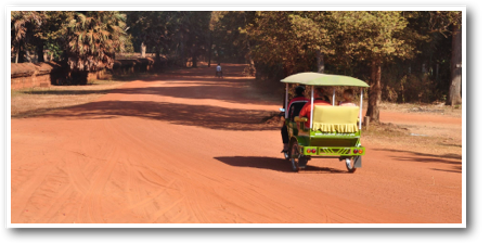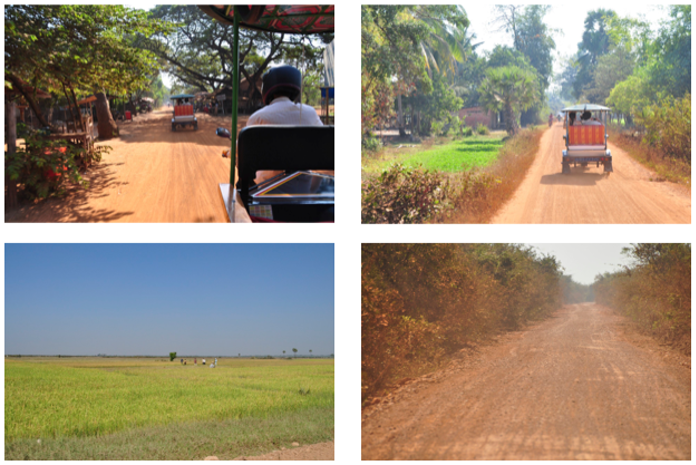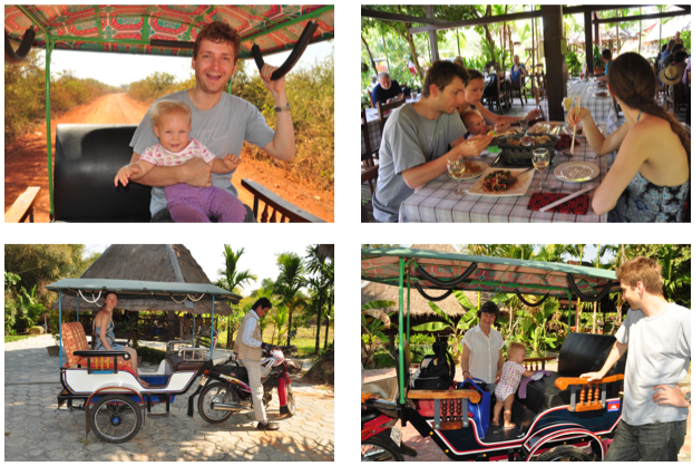
W ostatni dzień zwiedzania nasz przewodnik dał nam opcję do wyboru - jeździmy dalej busem albo wsiadamy do dwóch tuk tuk'ów. Zdecydowaliśmy się na tuk tuki. Zawsze to coś innego. Po śniadaniu ja i Piotrek z Mayą wsiedliśmy do jednego, a do drugiego teściowa, szwagierka i przewodnik. Pojechaliśmy najpierw poza Siem Reap, do świątyni Bakong w kompleksie Roluos. Świątynia Bakong pochodzi z końca IX wieku i jest to pierwsza świątynia-góra w architekturze Khmer'skiej. Ciekawostką było to, że świątynia i jej wejście jest bardzo dokładnie skierowana na wschód (sprawdzaliśmy z kompasem).
Our last day of sightseeing we had a choice of the same bus we used for the last two days, or do some travelling in a tuk tuk (actually two as we wouldn’t fit in one). We decided to take tuk tuks. Something different and should be interesting. After breakfast me and Piotr with Maya sat in one tuk tuk while Piotr’s mum and sister with our guide sat in the second tuk tuk. We went outside Siem Reap, to the Roluos temples complex and visited the Bakong temple. It was built at the end o 9th century and it is a first temple-mountain in the Khmer architecture. It was interesting to find out that the temple and its entrance was exactly facing east (we checked with a compass).

Obeszliśmy całość dosyć szybko a wracając do tuk tuków spotkaliśmy Kambodżańśkie krowy pasące się przy pobliskim stawie. Maya się nimi zachwycała ale my na nich nie zrobiliśmy chyba żadnego wrażenia ;)
We visited the temple pretty quickly and coming back to our tuk tuks we met a couple of Cambodian cows grazing by the nearby pond. Maya was more impressed with them then they were with us ;)

Kolejnym, i ostatnim już, punktem zwiedzania była wioska przy jeziorze i rzece Tonle Sap. Droga, którą jechaliśmy widoła przez pola ryżowe i dookoła nie było za wiele zabudowań, taka niezła dzicz Kambodżańska chociaż na początku jeszcze jakieś małe wioseczki mijaliśmy to później już było całkiem dziko. Droga nie asfaltowa, w kolorze pomarańczowym a dzięki jeździe tuk tukiem cały pył z niej kończył na naszych twarzach. Dotarliśmy do przystani gdzie wsiedliśmy na jedną z łodzi i popłynęliśmy zwiedzić wioskę.
The next, and last, sightseeing spot was a floating village by Tonle Sap Lake and River. The road we travelled to get there was pretty wild with rice fields around and nothing but rice fields, not too many buildings. Proper Cambodian wilderness. Initially we were passing some villages here and there but later it got pretty empty. The road was orange and sandy and if you travel it by tuk tuk, most of that orange dust ends up on your face and clothes. We got to the haven where we went on a long boat and travelled to visit the village.

Wioska jest spora i składa się w większości z prowizorycznych domów/chat/bud, lepszych i gorszych, które stoją na bardzo wysokich palach. W obecnym okresie pale stoją na suchym lądzie ale w porze letniej, deszczowej, poziom wody jest wysoki i 3/4 pali, które widoczne były teraz, znajdują się w wodzie. Droga, którą jechaliśmy aby dotrzeć do przystani z łodziami, w porze deszczowej po prostu nie istnieje.
The village is pretty big and it consists mainly of huts/houses/buildings, some in pretty nice condition, some look as if they were to fall aport tomorrow. All stand on very tall upright poles. At the moment the poles and all buildings stand on a dry land but once the summer comes, and the wet season, the water level goes very high and it comes to at least 3/4 of the poles. The road we went to get to the boats’ haven, doesn’t exist during the wet season.

Po przepłynięciu przez wioskę, dotarliśmy do jeziora Tonle Sap. Maya przespała tą trasę, obudziła się dopiero na jeziorze. Jezioro połączone jest z rzeką Mekong. Tonle Sap jest bardzo zmienne pod względem stanu wody, w zależności od pory roku. W porze deszczowej rzeka, którą płynęliśmy wzdłuż wioski i dotarliśmy do jeziora, zmienia kierunek swego biegu i zaczyna płynąć wstecz. Poziom wody w jeziorze gwałtownie się podnosi. Cofająca się rzeka nanosi do jeziora osady, wpływają też spore ilości ryb z Mekongu. Jest to jedno z najbardziej zasobnych w ryby słodkowodne akwenów na świecie. Po zakończeniu pory deszczowej woda błyskawicznie opada a rybacy często zdejmują ryby uwięzione na zalanych wcześniej drzewach. Wracając wzdłuż rzeki, napotykaliśmy się na lokalnych mieszkańców łowiących ryby.
After we went through the village, we got to Tonle Sap Lake. Maya slept through the whole trip and woke up once we got to the lake. Tonle Sap is connected by the river with Mekong and its flow changes direction twice a year. During the wet season, the river reverses and the water level in the lake raises dramatically. Reversing river brings sediment and there are also lots of fish coming from Mekong. It is one of the richest freshwater fish reservoir in the world. After the wet season ends, the water level drops quickly and the fishermen often have to remove the fish trapped in the trees that were previously under water. Coming back along the river, we met a lot of locals fishing here and there.

Wracaliśmy do hotelu tą samą drogą, po drodze wstępując na lunch do jednej z lokalnych restauracji.
We came back the same route and had lunch on the way in one of the local restaurants.

A tak wyglądało Siem Reap i okolice z tuk tuk’a:
That’s how Siem Reap and surroundings looked like from a tuk tuk:
GALERIA ZDJĘĆ / PHOTO GALLERY >>>
